“There’s a Charles Eames quote saying ‘take your pleasures seriously’,” says Jonathan Olivares, industrial designer, writer, curator and long-time skateboarder.
But the skateboard, a pleasure for Olivares and many others, hasn’t always been taken seriously: as a sport it has been villainised, yet will next year make its second appearance as an Olympic sport, and only in recent years has it been looked at as an object of design.
Days away from opening the new Design Museum exhibition, Skateboard, which Olivares curated with associate curator Tory Turk, Olivares admits that he was no exception: “I never really stopped skateboarding, but I treated it as a hobby that had nothing to do with my profession”. Making this exhibition, he says, was “really like stitching together a rift in my own life.”
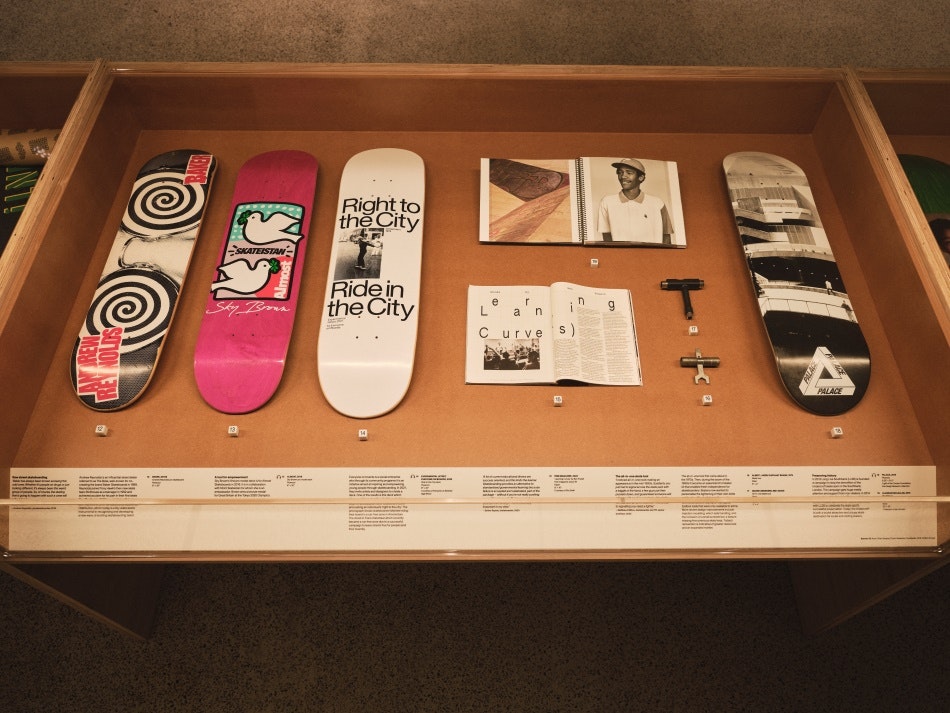
Rather than adding to the “many amazing books and exhibitions about skateboard graphics”, Olivares wanted to use his particular perspective and give back to the skate community, by looking to tell an untold design story to “put the skateboard on the same level as a Dieter Rams clock”.
According to Olivares, there are many influential industrial designers whose contribution to design and to the progression of the sport – their material and technical innovations always “in a kind of dance” with its milestones – deserve recognition.
A “piecemeal” history
Early on in the process Olivares was disappointed to find only “piecemeal” information about the skateboard’s industrial design history: “It was in 15 books and infinite magazines, and a few people I knew could tell me a little bit of the history”, he says.
Among the pioneering figures he found was Bob Denike, an industrial designer for “30 years or more” at NHS, the company behind Santa Cruz skateboards. Olivares explains that Denike first got into skateboard design from studying engineering, where “his thesis or senior project was thinking about new ways to make a truck”.
Whereas skateboard trucks were made from sandcast aluminium at the time, “a good process, but semi-industrial” and prone to breakages, Olivares explains, Denike switched to gravity casting, using a different grade of aluminium cast into a steel mould allowing for more precision and repeatability. Another early innovation was to expose the hanger on the underside of the truck”, referred to as a wing-shape, which removes weight from the skateboard, Olivares explains.
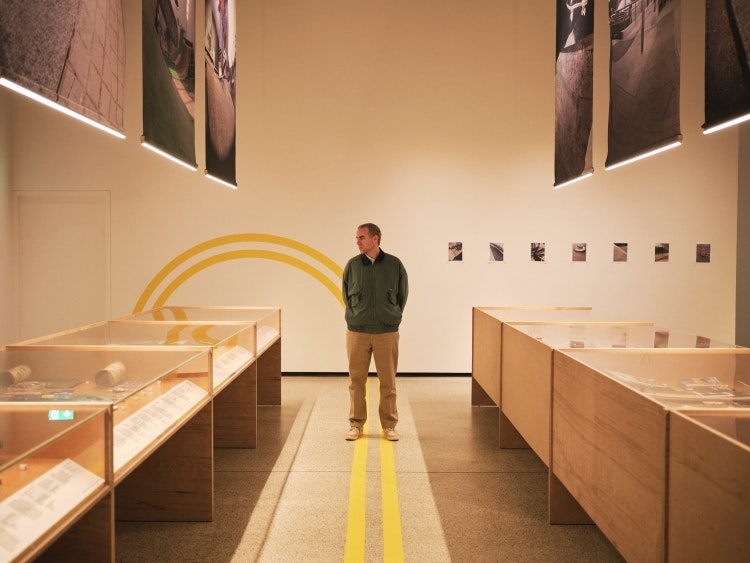
These innovations from the early 80s “have stuck”, Olivares says. “Most trucks today still use gravity casting and the hangers.”
“That was like a major contribution of industrial design and engineering […] At that point, you could almost say the truck reached maturity”.
With very little academic record of skateboard design history out there, other of the innovations that Olivares was looking to write into the history books remain elusive. Of the origins of the plywood board, he says there are three contesting accounts: in addition to Santa Cruz Skateboards and Willi Winkels in Canada, “we found a possible precedent, which was Larry Stevenson’s Makaha Alex 10, where he made what we believe to be a multi-plywood prototype from 1969 – which would technical predate all of the other plywood boards”, Olivares says.
The hardware of the skateboard
The “spine” of the exhibition, shown in glass-topped cabinets, are 100 skateboards as well as its hardware – “the trucks, the wheel, the bearings”.
Looking to treat the subject as comprehensively as possible, Olivares has arranged what is “very much a developing history”, chronologically, “to give the step-by-step evolution”.
Highlights include homemade 1950s versions of the skateboard, largely roller skate trucks nailed to wooden crates pioneered by surfers wishing to practice their moves, and the first two models to feature a kicktail – enabling new moves not derived from surfing.
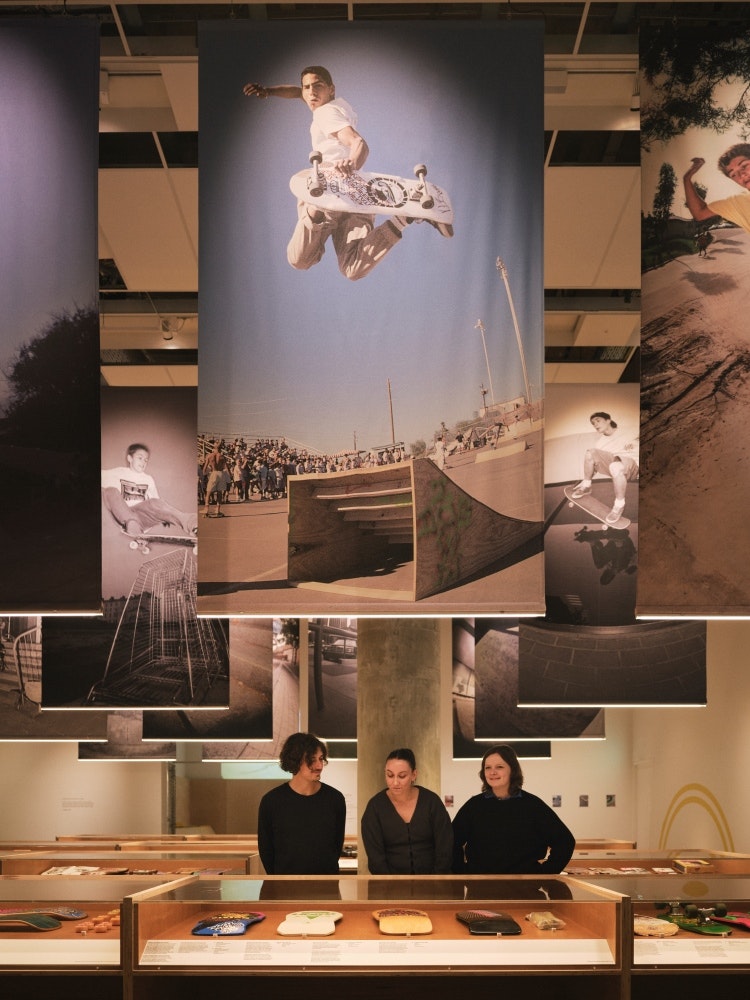
Also featured are the first boards of pro skateboarders, from the first pro women’s model of 1970 belonging to Laura Thornhill, Tony Hawk’s from 1982 and that of Sky Brown, Team GB skateboarder who won an Olympic bronze medal aged 13.
Many of the boards on show come from two prominent collectors. Todd Huber, who runs the Museum of Skateboarding and Skateboarding Hall of Fame in Simi Valley, California, has a collection that focuses on the 50s to the 80s. Complementing this is the collection from the 80s and 90 of Nick Halkias, who runs the SkateBoard Museum.
Their knowledge and connections and a wider oral history helped shape much of the exhibition. Olivares explains how one-by-one he was put in touch with Sean Cliver, a “renowned illustrator who was there for the whole history of skateboarding”; Lance Mountain, “part of the Bones Brigade and a very influential skateboarder”, designer Paul Schmitt, aka Professor Schmitt and more.
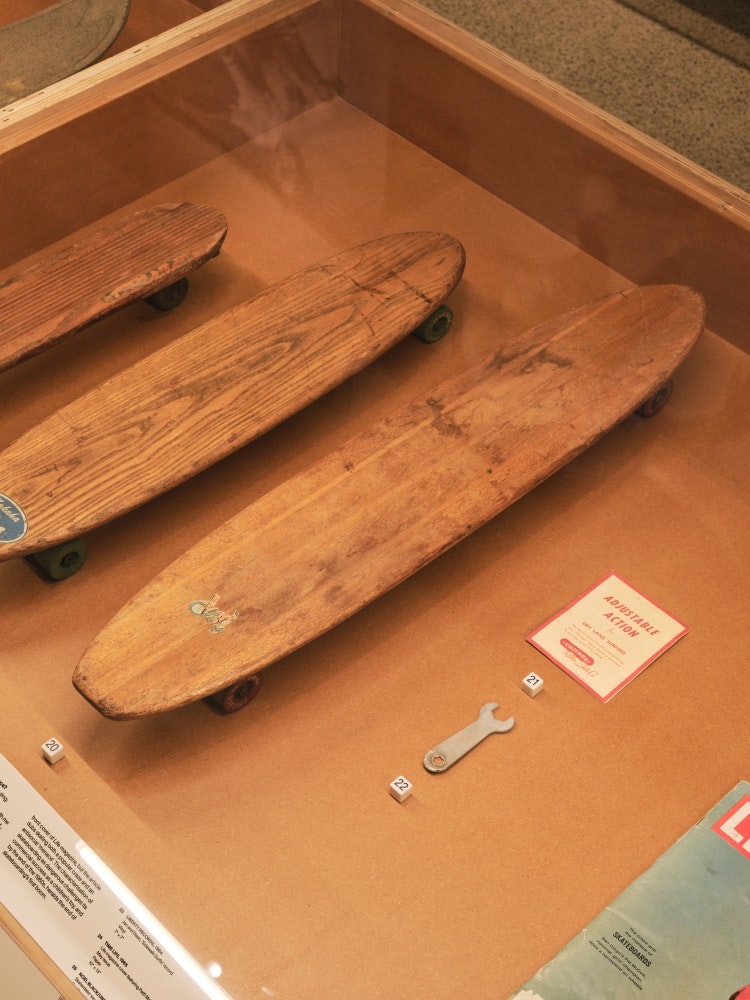
With vitrines containing the skateboards, contextualising the industrial design, is a “large photography gallery” – hanging from banners above – and supporting artefacts ranging from magazine spreads and VHS tapes to a type of camera used to film skateboarding and “the rule book from 1964 for the first organised skate competition by the National Skateboard Association in California”, Olivares says.
“We also pay homage to the UK skate scene, which was really there from the beginning”, Olivares adds, covering photography, magazines and skateboards from the UK – including the Palace Long Live Southbank 2017 deck, designed by the cult London skate brand to commemorate the successful protection of the popular skate spot on London’s Southbank.
Telling the story of skateboarding’s relation to the built environment is a film is produced by respected skating filmmaker and photo editor Buddy Coan Nichols, written by Olivares and voiced by pro skateboarder Alexis Sablone, who also studied architecture at MIT.
It takes visitors through the story of skateboarding as it travels from the “sidewalk, embankment in the schoolyard and the drainage ditch”, through 10-15-foot-tall concrete water pipes and swimming pools, to different waves of purpose-built skating infrastructure from experiments with concrete parks.
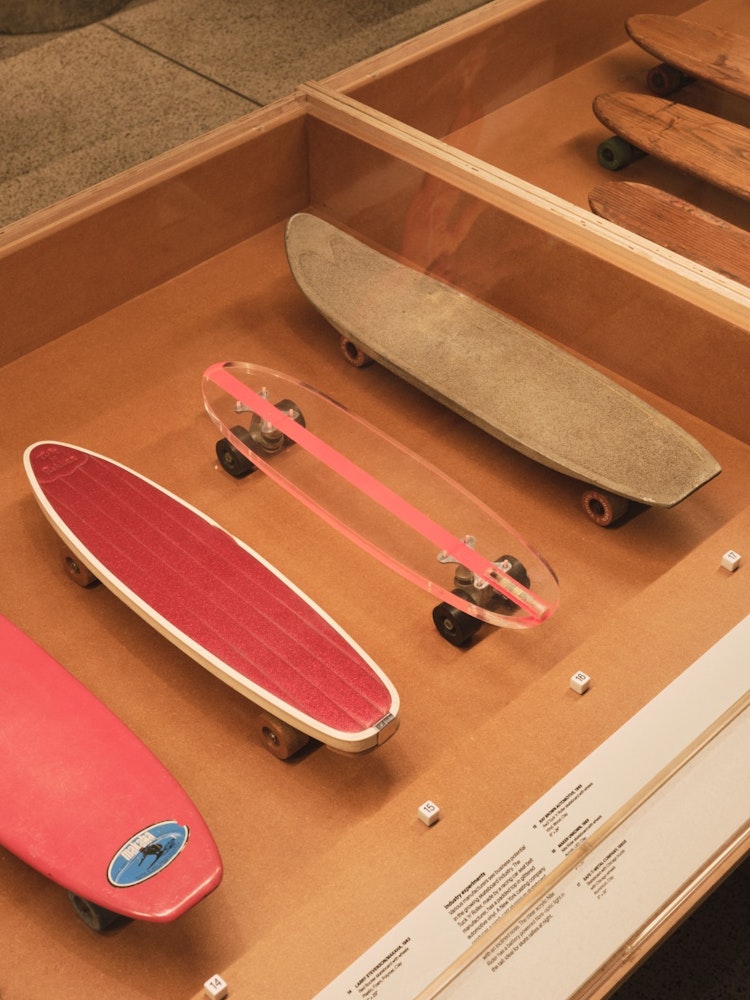
Recommended: “We should be more bullish”: Priya Khanchandani on curating design – Design Week
Meanwhile social factors such as industry “collapse” led to skateboarding moving “backyard and underground”, and with it the birth of the wooden half-pipe and new types of tricks. Then in the mid-80s, Olivares explains, those without access to ramps and parks take these new tricks back to the street – when “street skating proper was born”.
Another installation, which looks to make skateboarding “less abstract” is a purpose-built half pipe, from a local London-based skate park company Betongpark. This can be used by visitors who know how to skateboard, while others can take a seat and watch.
“Made by skateboarders”
As well as telling the design story of skateboards through the deep knowledge of its community, Olivares was adamant that the exhibition be “made by skateboarders”.
The 3D design of the show, led by Olivares, uses “materials that are native to skateboarding” such as plywood and Masonite, while the wayfinding graphics, which mimic the yellow-painted lines of the road, are a reference to a 1994 Spike Jonze-directed film for Girl Skateboards called Goldfish.
Meanwhile the photography “is all done by skate photographers from the last 50 years – and we licenced and paid those photographers for their work”, Olivares says.
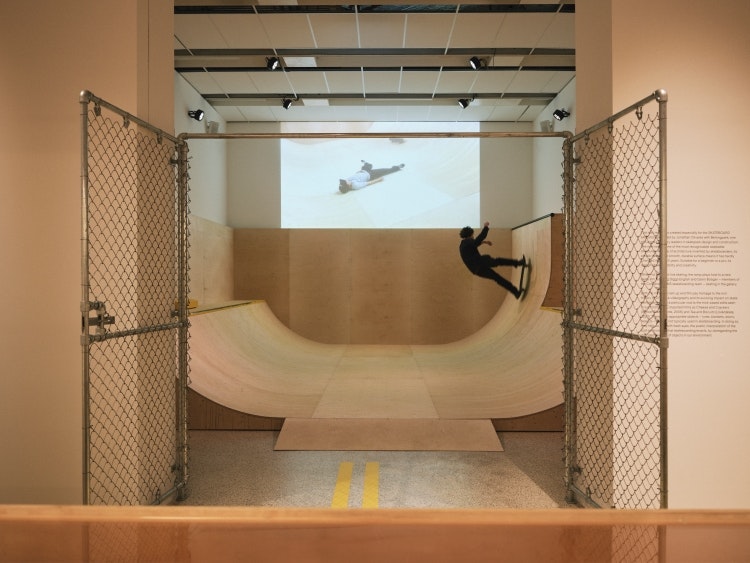
“It was very important for me that any funding that came into this exhibition” – which comes from shoe brand Converse – “went right back to the skate community”, says Olivares.
The one exception is the 2D graphics, designed by frequent Apartamento Studios, which Olivares describes as “clean, simple graphic design”.
“I felt in order to put the skateboard on the same level as a Dieter Rams clock, you had to have some degree of ‘design-world-design’ hosting the content”.
While some would expect him to tap into the legacy of skateboard graphics, Olivares wanted the graphics to play a “secondary or supporting role”.
“The beautiful thing about skateboard graphics is that they tend to have a lot of identity”, he adds.
Beyond this reminder that this is very much an exhibition of design, immersive elements such as to the sounds of skateboarding – rolling wheels and musical soundtrack typical to the genre of skate videos – as well as the “big rectangular volume” of skateboard-filled vitrines, look to put visitors “into the world of skateboards and skateboarding”.
Skateboard is open from 20 October 2023 to 2 June 2024 at the Design Museum, 224-238 Kensington High Street, Kensington, London W8 6AG.
Banner image: James Griffiths for Converse
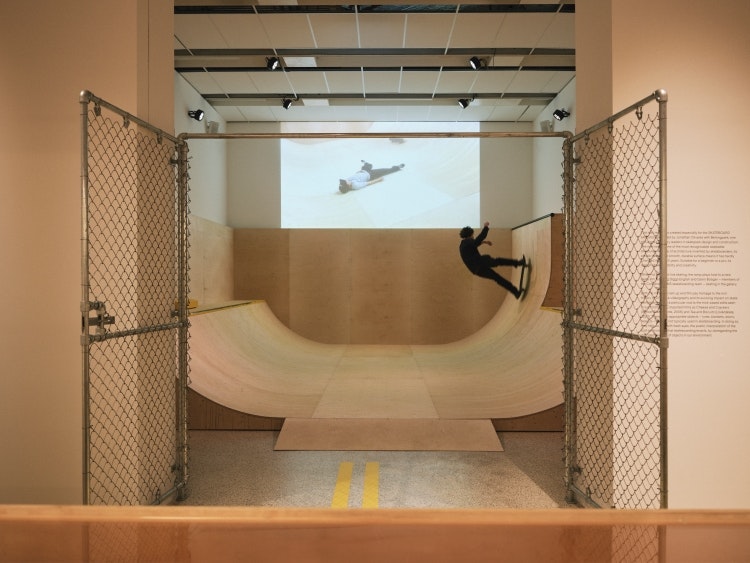
- Design disciplines in this article
- Industries in this article
- Brands in this article








